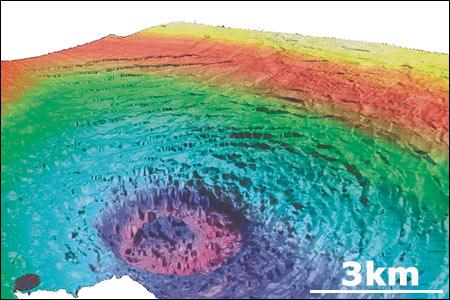The geological structure named Silver Pit lies a few hundred meters below the North Sea, about 130 kilometers east of the Yorkshire coast. The new images show a spectacular series of rings extending out for 3 kilometers from the central hole.
Avi Blizovsky

The Silver Pit crater is in the depths of the sea
What is believed to be Britain's only impact crater is now being mapped in detail and in XNUMXD for the first time.
The geological structure named Silver Pit lies a few hundred meters below the North Sea, about 130 kilometers east of the Yorkshire coast. This is how the BBC website reports that the new images show a spectacular series of rings that extend out to a distance of 3 kilometers from the central hole.
Researchers reported the description of the findings and their interpretation of the images in the American Geological Society's Bethune.
Dr. Simon Stewart and Phil Allen detailed how the crater pattern might have developed as a result of the catalytic fall of an asteroid or comet 60-65 million years ago.
The geomorphology of the crater matches that of impact craters on Mars and other bodies in the solar system. Allen told the BBC.
There are scientists who oppose this claim. The pair, who first reported finding this underwater formation in 2002, hope their new estimates based on seismic resonance will put an end to the debate.
other worlds
Today the Silver Pit is covered with sand almost a kilometer deep. Only the seismic data collected by oil companies in their search for oil and natural gas fields allowed us to know about these magnificent formations cut into the limestone.
The entire area underwent geological changes over time - stretched on one side and compressed on the other.
Allen and Stewart say the inner bowl contains a 300-meter-high central ridge, or nipple, typical of impact craters.
This bowl is surrounded by dense rings formed by rocks that collapsed along the lines of weakness. The rings stretch almost ten kilometers from the center of the crater.
"As far as we know, the structure is quite unique." said Alan, a geophysical consultant at Geoscience Productions in Aberdeen.
"We estimate that the rings are a product after the injury. In our estimation there were two phases - the first during the impact, specific areas were weakened and the configuration of the rings was defined. Much later, perhaps millions of years later, the rings themselves were formed.
Although a formation like Silver Pit doesn't exist anywhere else on Earth or in the inner planets, Allen and Stewart say such dense rings are similar to craters on Jupiter's icy moons like Europa and Callisto. The two believe that there should be a connection with the type of ground on which the celestial body hit. "The moons of Jupiter are hit by objects in the ice mantle, under which there are probably salty oceans. The question is what is hidden under the chalk of Silver Pit, will the slate transfer the energy? We are sure that the nature of the layers at the site of injury is important.
If, as Stewart and Allen believe, a 7-million-ton, 120-meter-wide object hit Earth at 20 meters per second, the local rocks should show evidence of melting and metamorphism. Samples dug during gas exploration in the area may locate this. They may also provide a more accurate dating of the Silver Pit structure.
In addition, any impact could have thrown materials over large areas. This emission, which took a familiar and recognizable form, may give its signals in Great Britain and Scandinavia.
And it is also possible to find effects of tsunami waves. Silverpit was covered by a shallow sea at the beginning of the Tertiary. An impact could have sent huge waves to the nearby land masses. It will be difficult to find evidence of this disorder in the fossil record.
https://www.hayadan.org.il/BuildaGate4/general2/data_card.php?Cat=~~~110076368~~~35&SiteName=hayadan

One response
The impact speed is 20 km per second and not twenty meters per second
Good night
Yehuda